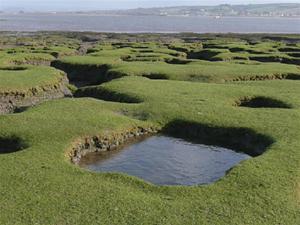Skern
Salt-marsh is an area of mud flat which has vegetation established on it. Salt-marsh is a fragile and constantly changing habitat.

Estuaries fill with fine sediments which settle and build up to become mudflats. Channels are formed as the tide recedes. Water drains from the marshes and cuts small channels which in time become deep gullies. They are also increased by erosion of the gully sides which may be undercut and therefore collapse.
The mud is rich in microscopic algae and organic matter. This mix provides a rich food supply for Lower Spire Shells and Lug Worms. Usually the only sign of these worms are the coiled casts left behind on the surface. Shore Crabs can also be found half buried in the mud as they await their next meal.
There are few visible plants here but mats of green algae carpet the surface of the mud on the lower mudflats. Moving further up the shore it is replaced by glasswort (so called because of its use in the manufacture of glass in the past). It grows higher up the shore due to its inability to withstand submergence for long periods of time. Sea Blite can also be found in this area.
Once these plants are established they slow the flow of water which in turn causes more sediments to be deposited. As the mud becomes higher and drier new species start to colonise like Red Fescue which is grazed by sheep in the summer months.
Mudflats and salt-marshes provide an important source of food for wintering birds. Some birds such as Brent Geese spend the summer months in the Arctic due to long daylight hours which in turn means longer feeding hours. During the winter they fly south to feed on the British estuaries.
The sounds of Curlew and Oystercatchers can be heard echoing across the Skern. Ringed Plover can be seen dancing along the shore trying to attract the worms from the mud below. The elegant Greenshank and Redshank wade through the gullies whilst Turnstones camouflaged against the stones and seaweed dash back and forth in search of Sandhoppers. Flocks of Dunlin mask the sky above as they circle looking for a place to settle. Golden Plover, Shelduck, Bar Tailed Godwits and Little Terns can all be spotted feeding on the mudflats.
The birds can be viewed from along- side the road which overlooks the Skern. A good pair of binoculars and a flask of coffee is all that's needed for an enjoyable days viewing. The best time is 1 - 2 hours before high tide.
(Please note that the species you see will depend on the time of year that you visit)




